IC 417 in Hubble Palette
 Click image for full size version
Click image for full size version
January 23, 2022
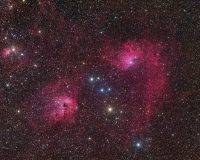 IC 417 is an emission nebula in the constellation Auriga, lying about 10,000 light years away. The glowing centre of the nebula is energized by the hot, massive blue stars embedded within. New stars are being formed in the ovals left of centre and the surrounding nebula. NGC 1931 is the compact oval nebula to the upper right. This region is informally known as “The Spider and the Fly” and I can see why. This image was made with 3nm narrowband filtersand is rendered in the Hubble Palette.
IC 417 is an emission nebula in the constellation Auriga, lying about 10,000 light years away. The glowing centre of the nebula is energized by the hot, massive blue stars embedded within. New stars are being formed in the ovals left of centre and the surrounding nebula. NGC 1931 is the compact oval nebula to the upper right. This region is informally known as “The Spider and the Fly” and I can see why. This image was made with 3nm narrowband filtersand is rendered in the Hubble Palette.
The natural-colour image, left, shows IC 417 (upper left) with IC 405 and IC 410.
Tekkies:
Acquisition, focusing, and control of Paramount MX mount with N.I.N.A., TheSkyX and PHD2. Focus with Optec DirectSync motors and controller. Equipment control with PrimaLuce Labs Eagle 4 Pro computer. All pre-processing and processing in PixInsight. Acquired from my SkyShed in Guelph. Average transparency and seeing. Acquired January 29-March 3, 2022, mostly under a moderately moonlit sky.
Sky-Watcher Esprit 150 f/7 refractor and QHY600M camera with Optolong H-alpha, O(III) and S(II) 3nm filters
13x20m O3 = 4hr20m
13x20m S2= 4hr200m
97x5m OSC = 12hr15m (for star colour only)
The WeightedBatchPreProcessing script was used to perform calibration, cosmetic correction, weighting, registration and integration of all frames.
Chrominance
Creation and cleanup: The S2, Ha and O3 were combined to make an RGB image. DynamicBackgroundExtraction and BackgroundNeutralization were applied to the image.
Linear Noise Reduction: MultiscaleLinearTransform was used to reduce noise in the RGB image. Layer settings for threshold and strength: Layer 1: 5.0 0.85 Layer 2: 4, 0.75 Layer 3: 3, 0.64 Layer 4: 2.0, 0.2 Layer 5: 1, 0.1.
Stretching: HistogramTransformation was applied to make a pleasing, bright image, with background set to an intensity of approximately 0.10
Luminance
Creation of Synthetic Luminance: ImageIntegration was used to make a noise-weighted average of the three narrowband masters. This was used as synthetic luminance.
Deconvolution: A star mask was made to use as a Local Deringing Support image. A copy of the image was stretched to use as a deconvolution mask. Deconvolution was applied (45 iterations, regularized Richardson-Lucy, Parametric PSF mode).
Linear Noise Reduction: MultiscaleLinearTransform was used to reduce noise in the background areas, using an internal mask to protect bright structures. Layer settings for threshold and strength: Layer 1: 4.0 0.9 Layer 2: 3.0, 0.75 Layer 3: 2.0, 0.6 Layer 4: 0.5, 0.2.
Stretching: HistogramTransformation was applied to make a pleasing, bright image, with background set to an intensity of approximately 0.10.
Combining Luminance and Chrominance
LRGB Combination: The synthetic luminance was applied to the chrominance image using LRGBCombination with default settings.
Additional Processing
Temporary Star Removal: Starnet2 was used at default settings to temporarily remove the stars and produce a separate image containing the stars.
Nonlinear Noise Reduction: TGVDenoise was used in L*a*b* mode to reduce noise with the starless image selected as the Local Support image (used like an external mask would be, to target the background areas and protect the stars and galaxy) (max. 1,000 iterations and convergence selected for both lightness and chrominance).
Contrast Enhancement: LocalHistogramEqualization was applied three times to the starless image using a mask to protect the background, with one iteration each at maximum contrast of 1.5 and scales of 20, 50 and 150 (strength 0.2, 0.18 and 0.25 respectively).
Sharpening: MultiscaleMedianTransform was used to sharpen Layers 2, 3 and 4 with strengths of 0.15, 0.07, and 0.05, respectively, through the same mask used for the previous step.
Addition of RGB Stars to Starless Image: PixelMath was used to add RGB stars into the starless image using the expression $T + star_mask with rescaling. The star_mask image was made by extracting the stars from the one-shot colour image made using the workflow described here.
Final Steps: Background, nebula and star brightness, contrast, and colour saturation were adjusted in several iterations using CurvesTransformation with masks as required. ICCProfileTransformation (sRGB IEC61966-2.1; Relative Colorimetric with black point compensation) was applied prior to saving in jpg format.

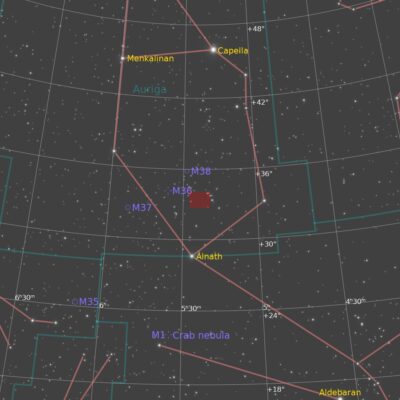
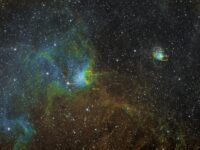
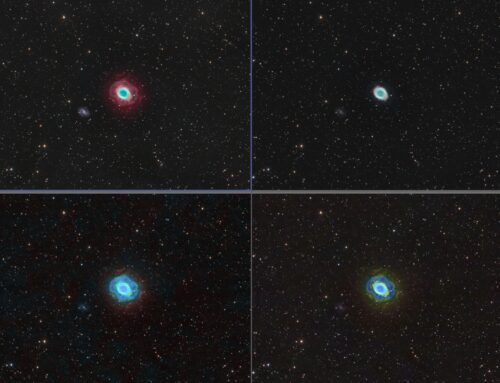



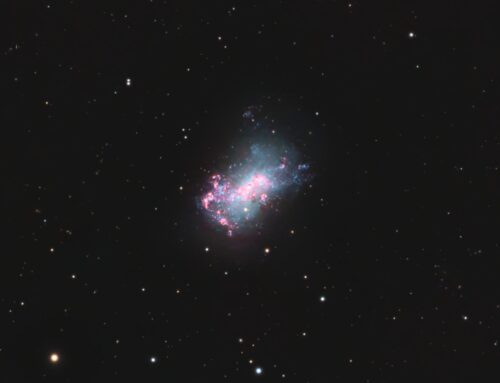
Absolutely stunning…Fabulous job Ron! Your image notes are so valuable to all…keep up the great work.
Thank you!
You have a gift! Gorgeous photo!
Thanks!